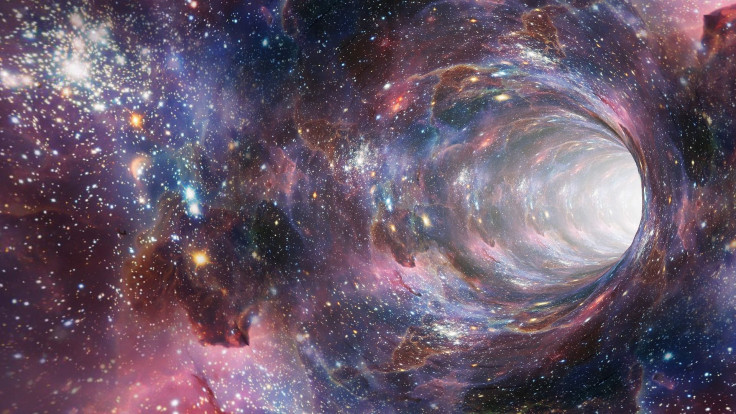Scientists Say Wormholes Are Real: Black Holes Connected Through Quantum Teleportation

A new theory about black holes can solve both a conundrum and a paradox — how do we find out what’s inside a black hole and what happens to these space suckers at the end of the universe? Scientists have proposed a concept in which a quantum connection between two black holes can hold open an Einstein-Rosen bridge between them, a pathway better known as a wormhole, whose terminals are different points in space and time.
Previous scientific calculations have suggested that any wormholes created in the universe would collapse right away unless something were to hold it open — a so-called “exotic material” sent into the tunnel that keeps it stable by pushing space-time away from itself, like two magnets of the same polarity. The new idea takes the exotic material out of the equation, with the trio of scientists behind it saying in their paper that the connection between the two black holes at the opposite ends of the wormhole could hold the pathway open and make it traversable.
Although it may sound like magic that two black holes at separate ends of space and time could have a connection to one another, the concept is similar to quantum teleportation, as the researchers note in their paper. And quantum teleportation, while not yet perfected, is something scientists have been advancing upon in recent years. For example, earlier this year a team of Chinese researchers was able to transfer the properties of photons on Earth to photons that were on a satellite in space. Those photons at different altitudes were entangled — a fancy word for connected. The entire basis of quantum teleportation is transferring properties of one group of particles to another, across vast distances.
Solving this mystery of wormholes can potentially answer a number of other questions for scientists. There is, of course, the mystery of what the inside of a black hole is like. Perhaps it would not be so that the only explorers who could tell us would be dead.
“What I really like … is that an observer can enter the black hole and then escape to tell about what she saw,” black hole and quantum gravity expert John Preskill, who is at Caltech and was not one of the study’s authors, told Quanta Magazine.
Another issue that could be solved is the black hole paradox. If black holes are not connected to anything, all the information about the universe’s matter that falls into them is trapped in there forever. But research has shown that black holes slowly radiate away their mass as if they are evaporating, “like a hot pot on a stove losing its water as steam,” Kurzgesagt has explained. A black hole the size of our sun would take “10,000 billion billion billion billion billion billion years to lose 0.0000001 percent of its mass.” And when it slowly fades into nothingness at the end of the universe, it takes everything it has consumed with it.
What’s the problem with that? One key principle of physics is that information cannot be lost in this way.
The new concept about wormholes being held open by a quantum connection between black holes could solve this information paradox. The two black holes might become linked when one encounters the radiation from the other’s slow evaporation, according to Quanta Magazine.
“They have to be causally connected and then the nature of the interaction that we took is the simplest thing you can imagine,” paper co-author Daniel Jafferis told that publication.
© Copyright IBTimes 2024. All rights reserved.





















